Intel Core 2 Duo E6750 Preview: The Desktop Gets a 1333MHz FSB
by Anand Lal Shimpi on June 25, 2007 2:57 AM EST- Posted in
- CPUs
Gaming Performance
We're testing with a handful of new titles in today's review, many of which are far from CPU bound even at relatively low (by today's standards) resolutions. For our S.T.A.L.K.E.R. and Supreme Commander tests we had to reduce the in-game resolution to 1024 x 768, while Rainbow Six: Vegas and Lost Planet both required 800 x 600 in order to produce measurable differences between these CPUs.
On the one hand, this is good news for those looking to build gaming PCs on lower end processors. On the other hand, it means that we have to test with less real world settings in our CPU reviews to accurately compare overall gaming performance of modern day CPUs. The CPU/GPU boundry pendulum will continuously swing from one end to the other, we're simply at a point today where even the almighty GeForce 8800 GTX can't run everything perfectly smoothly at 1600 x 1200.
As CPUs and GPUs converge, games will undoubtedly become even more compute bound, but it's difficult to predict what effect this will have (if any) on the balance between sequential and highly parallel general purpose processing.
Our first 3D game test is our walkthrough of Bruma in the popular RPG Oblivion. This test was run at 1600 x 1200 with Very High quality defaults selected from Oblivion's launcher. FRAPS was used in this benchmark:

Oblivion was one of the two benchmarks that showed a significant performance improvement due to the faster 1333MHz FSB. Looking at the E6420 vs. 5600+ comparison, AMD actually pulls ahead here thanks to its aggressive pricing.
We ran Half Life 2: Episode One at 1600 x 1200, with all settings at their maximum values with the exception of AA/anisotropic filtering, which we left disabled.
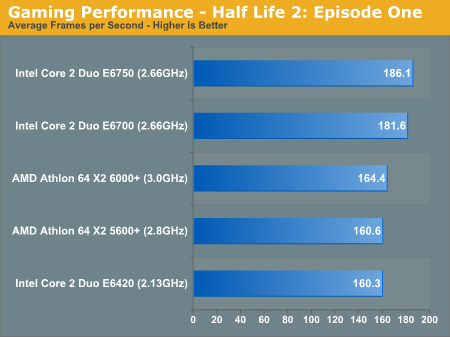
A small improvement for the 1333MHz FSB, and AMD continues to win the performance battle at ~$180.
We ran Prey at 1600 x 1200 with High Quality textures, all detail settings were set to their highest options, no AA, and 8X aniso:
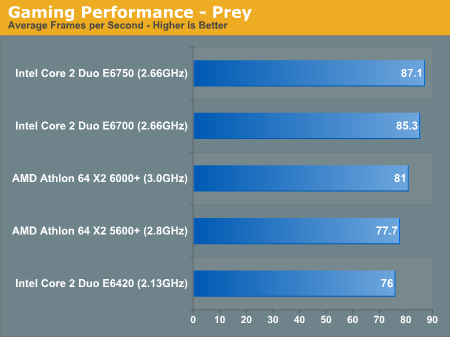
S.T.A.L.K.E.R. was tested at 1024 x 768 with full dynamic lighting enabled and high quality detail settings:
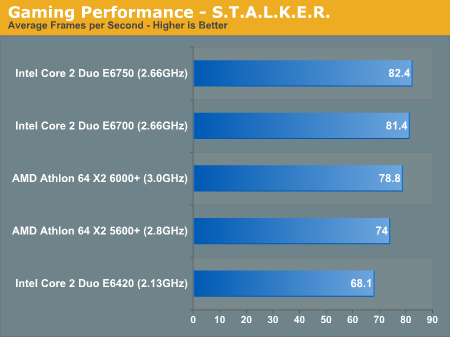
We ran Supreme Commander at 1024 x 768 with medium quality presets. We ran a subset of the built in performance test, specifically we only used the third performance test in the script as it was the most CPU bound.
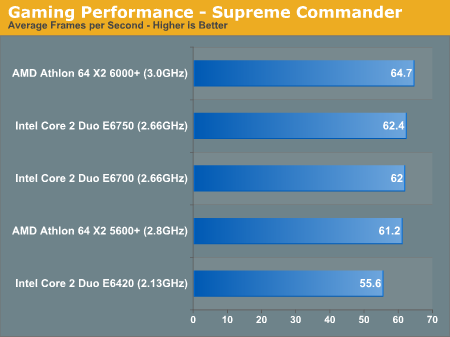
Rainbow Six: Vegas proved to be particularly GPU bound, even at 800 x 600. We left most detail options enabled/high, with the exception of the eye effect setting.

Capcom's Lost Planet demo is available in both DX9 and DX10 flavors, but for this review we used the DX9 version given that we've not been able to find any real benefit to running the DX10 version. Just like RS:V, we had to run Lost Planet at 800 x 600 with a mixture of high/medium quality settings:
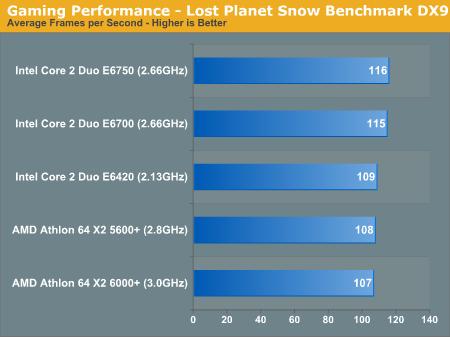
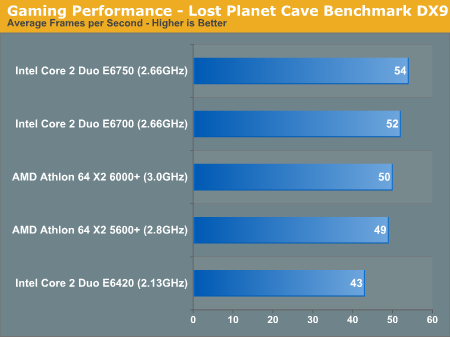










42 Comments
View All Comments
mbf - Monday, July 23, 2007 - link
I've been wondering how older motherboards will work with the new FSB1333 processors. Specifically I'm interested how an ASUS P5W DH Deluxe without the latest BIOS would react to having e.g. an E6750 dropped in. ASUS claims support for FSB1333 processors for the P5W DH Deluxe as of 2205 beta.Would the system boot and run using a pre-2205 BIOS (although not at peak performance), so a BIOS upgrade can be performed? Or would the system fail to boot at all, like when the first Core 2 Duo processors surfaced and needed a BIOS upgrade to run at all on certain boards.
The reason I ask this is that I've my eyes set specifically on that board (I have several reasons, ECC memory support being one of them). I had originally planned on getting an E6600 after the July 22 price cuts, but right now there's nearly no FSB1066 processor to be had locally. Also, I'd of course love to have a access to the latest processors in any case.
myrubbish - Tuesday, July 17, 2007 - link
which one is original ?http://www.hardspell.com/english/doc/showcont.asp?...">http://www.hardspell.com/english/doc/showcont.asp?...
kobymu - Tuesday, June 26, 2007 - link
If at all possible, I would like to see the impact ofA) 1333MHz FSB with DDR2
B) DDR3 bandwidth
C) both 1333MHz FSB with DDR3
on quadcore in multiprocessing scenarios, preferably the non synthetic ones.
myrubbish - Tuesday, July 17, 2007 - link
which one is original ?http://www.hardspell.com/english/doc/showcont.asp?...">http://www.hardspell.com/english/doc/showcont.asp?...
AnnonymousCoward - Monday, June 25, 2007 - link
I noticed that last picture shows 1.088V, and my E6600 is rated at 1.325V (and measures 1.328-1.344V). Did Intel lower the voltage for this new series? This wasn't addressed.457R4LDR34DKN07 - Monday, June 25, 2007 - link
Y should I pick 1 of these up when a 2.66 GHz quad core will be avalable at $266 dollars. much better perfomance even at 1066 FSB and thats before overclock.Chunga29 - Monday, June 25, 2007 - link
I see both listed, with the same price and same features. What exactly then is the purposed between having two model numbers? Does one of them not have virtualization? Even if that's the case, why bother? I mean, are there times when virtualization (even if disabled) would be a bad thing? Or maybe it's just a mistake in the table and I'm reading too much into it?Anand Lal Shimpi - Monday, June 25, 2007 - link
The E6550 has Intel Trusted eXecution Technology (TXT), while the E6540 does not. The model numbers would be far too easy to understand without curveballs like that :)Take care,
Anand
SunAngel - Monday, June 25, 2007 - link
I like the artice and understand it is just based on dual cores. However, I believe that everyone, including myself, really would like to know which will be faster for encoding jobs the 2.4 quad-core 1066FSB or the 3.0 dual-core 1333FSB? Since encoding is big business now, it is no secret that raw power is everyones wish. So, the sooner you can get me this benchmark, the sooner I can get back to clicking on advertisements.Anand Lal Shimpi - Monday, June 25, 2007 - link
It's a very valid and important request, but I do believe it's one we've already answered :) If you look back to our article on the Core 2 Extreme QX6800, I tested a Core 2 Quad Q6600 (2.4GHz/1066/quadcore) and a Core 2 Extreme X6800 (2.93GHz/1066/dualcore). While the X6800 not quite the E6850 (3.0GHz/1333), it's close in performance so you should be able to get an idea of the performance comparison:http://www.anandtech.com/cpuchipsets/intel/showdoc...">
To save you the trouble of looking, the Core 2 Quad Q6600 is a better buy strictly for encoding if you're doing DivX/WME encoding. Our Windows Movie Maker and Quicktime tests show the Q6600 falling behind the X6800, but for DivX encoding and heavy WME work (and potentially H.264 encoding on other software platforms) you'll be better off with the Q6600.
I hope this helps :)
Take care,
Anand